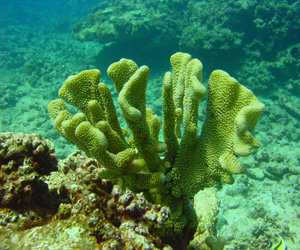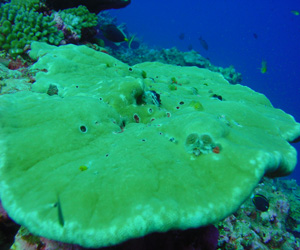10st Nov - 17th Nov, 2004

Fringing reef of atoll
30°C
Estimate of less than 5% corals show bleaching but with temperatures sustained at current levels, there could be a bleaching event here this season. The majority of colonies bleaching are Pocillopora.
There were no visible signs of disease.
Up to 20 meters
3 observed on dive south of jetty, none observed on northwest reef
Atafu Atoll is one of the three atolls that make up Tokelau, lying approximately 350 nautical miles to the north of western Samoa. There is a permanent population of about 500 people on the atoll – all on the western motu where they are more protected from the east/south-east trade winds. Many islanders move to New Zealand or Australia and the teenagers school in Samoa.
There are few visitors to Tokelau – it is only reachable via the supply boat from Apia, Samoa. There are no hotels or guesthouses. There is a mooring buoy for ships to tie to, so anchor damage on the reef is minimized.
The islanders are careful to manage their natural resources. There are many rules regarding fishing operations – for example, fishing is only allowed inside the lagoon on certain days since this becomes a valuable resource when the sea is too rough for fishing outside the lagoon. Fishing practices on the reef are non-destructive and sustainable – trolling, line fishing. The houses have toilets which run to septic tanks. Rain water is collected off the roofs of the houses and runs down into concrete water tanks which are the building’s foundations. Coconut crabs are only allowed to be hunted in certain seasons to avoid their eradication from the island (as has happened on so many other islands of the South Pacific). Giant clams too are carefully monitored and managed. Local fishermen rarely use anchors on the reef. The islanders told us that there is no ciguatera in their reef fish.
On the west outer side of the atoll, the reef rises from quite a steep drop off to a wide reef flat, about 10 metres deep, which graduates to solid limestone formations that act as breaker zones. There are some very interesting natural arches on the outside of these limestone mounds, and canyons that then run through into the lagoon. The sea level inside the lagoon is a little higher than outside, so there is a continuous cascade of water flowing out. There are large areas of corals on the reef flat that are overgrown by a pink calciferous algae.
At the north-west tip, the reef stretches away from the atoll strip to a point about a third of a mile offshore. Here, the reef slopes much more gently down to about 30 metres, again rising to a very wide reef flat at about 10 metres depth. There are substantial rubble areas on the slope and at the edge of the reef flat – footprints of past storms and cyclones. The breakers here varied in height but reached up to 10 feet (while there were no westerly swells).
Inside the lagoon there is much lower coverage and diversity but the corals there are in a good state of health. There is also a reasonable fish population inside the lagoon, which is their stock for when the weather is too rough to take boats outside.
Fish diversity is high and populations are extremely healthy. There are large amounts of parrotfish, surgeonfish, unicornfish, damselfish, butterflyfish. We saw many eagle rays. Also one day a flock of about 30 napoleon wrasse from small to large, all gathered on one part of the northwest reef. School of great barracuda. Plenty of sharks – white tip, black tip and grey reef sharks including juveniles. Many groupers including large adults. It is the mating season right now for the giant trigger fish.

The level of coral diversity is about the same as we have seen in the Cook Islands. The reef flats were predominantly covered by Pocillopora, Montipora, Acropora and Porites colonies. Many colonies have been overgrown by calciferous algae, especially on the reef flat. Many corals show storm damage, fish bites, overgrowth by sponge or tunicate, boring organisms etc. But there is clearly enough of a hard coral substrate to support the reef system. We also had many sightings of sea turtles including lucky Nada who snorkeled with 14 of them at one moment!